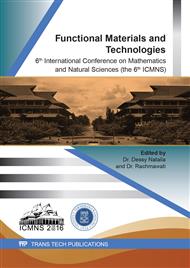[1]
Information on http://www.doc-developpement-durable.org.
Google Scholar
[2]
S.S. Bhadoriya, A. Ganeshpurkar, J. Narwari, G. Rai, A.P. Jain, Tamarindus indica: Extent of explored potential, Pharmacogn. Rev. 5 (2011) 73-81.
DOI: 10.4103/0973-7847.79102
Google Scholar
[3]
F.M. Setyowati, Etnofarmakologi dan pemakaian tanaman obat suku Dayak Tunjung di Kalimanta Timur, Media Litbang Kesehatan 20, (2010) 104-112.
Google Scholar
[4]
E.D. Caluwѐ, K. Halamová, P.V. Damme, Adansonia digitata L.: A review of traditional uses, phytochemistry and pharmacology, Afrika Focus 23 (2010) 53-83.
DOI: 10.21825/af.v23i1.5037
Google Scholar
[5]
J.H. Doughari, Antimicrobial Activity of Tamarindus indica Linn, Trop. J. Pharm. Res. 5 (2006) 597-603.
Google Scholar
[6]
U.U. Nwodo, G.E. Obiiyeke, V.N. Chigor, A.I. Okoh, Assessment of Tamarindus indica extracts for antibacterial activity, Int. J. Mol. Sci. 12 (2011) 6385-6396.
DOI: 10.3390/ijms12106385
Google Scholar
[7]
Y. Sudjaroen, R. Haubner, G. Würtele, W.E. Hull, G. Erben, B. Spiegelhalder, S. Changbumrung, H. Bartsch, R.W. Owen, Isolation and structure elucidation of phenolic antioxidants from Tamarind (Tamarindus indica L.) seeds and pericarp, Food Chem. Toxicol. 43 (2005) 1673-1682.
DOI: 10.1016/j.fct.2005.05.013
Google Scholar
[8]
T. Tsuda, M. Watanabe, K. Ohshima, A. Yamamoto, S. Kawakishi, T. Osawa, Antioxidative components isolated from the seed of Tamarind (Tamarindus indica L.), J. Agric. Food Chem. 42 (1994) 2671-2674.
DOI: 10.1021/jf00048a004
Google Scholar
[9]
A.A. Ajayi, R.A. Oderinde, D.O. Kajogbola, J.I. Uponi, Oil content and fatty acids composition of some underutilied legumes from Nigeria, Food Chem. 99(1) (2006) 115-120.
DOI: 10.1016/j.foodchem.2005.06.045
Google Scholar
[10]
R.W. Andriamanantena, J. Artaud, E.M. Gaydou, M.C. Iatrides, J.L. Chevalier, Fatty acid and sterol compositions of malagasy tamarind kernel oils, JAOCS. 60 (1983) 1318-1321.
DOI: 10.1007/bf02702108
Google Scholar
[11]
C.J. Zheng, J.S. Yoo, T.G. Lee, H.Y. Cho, Y.H. Kim, W.G. Kim Fatty acid synthesis is a target for antibacterial activity of unsaturated fatty acids, FEBS Letters 579 (2005) 5157-5162.
DOI: 10.1016/j.febslet.2005.08.028
Google Scholar
[12]
F. Dilika, P.D. Bremner, J.J.M. Meyer, Antibacterial activity of linoleic and oleic acids isolated from Helichrysum pedunculatum: a plant used during circumcision rites, Fitoterapia 71 (2000)450-452.
DOI: 10.1016/s0367-326x(00)00150-7
Google Scholar
[13]
L.J. McGaw, A.K. Jager, J.V. Staden, Isolation of antibacterial fatty acids from Schotia brachypetala, Fitoterapia 73 (2002) 431-433.
DOI: 10.1016/s0367-326x(02)00120-x
Google Scholar
[14]
A. Vogel, Textbook of Practical Organic Chemistry, 4 ed., Longman, London, (1978).
Google Scholar
[15]
X. Li, W. Kong, W. Shi, Q. Shen, A combination of chemometrics methods and GC-MS for the classification of edible vegetable oils, Chemom. Intell. Lab. Syst. 155 (2016) 145-150.
DOI: 10.1016/j.chemolab.2016.03.028
Google Scholar
[16]
U. Tril , J.F. Lopes, J.A.P. Álvarez, M.V. Martos, Chemical, physicochemical, technological, antibacterial, and antioxidant properties of rich-fibre powder extract obtained from tamarind (Tamarindus indica L.), Ind. Crop. Prod. 55 (2014) 155-162.
DOI: 10.1016/j.indcrop.2014.01.047
Google Scholar
[17]
J.J. Kabara, D.M. Swieczkowski , A.J. Conley, J.P. Truant, Fatty acids and derivatives as antimicrobial agents, Antimicrob. Agents Chemother. 1 (1972) 23-28.
DOI: 10.1128/aac.2.1.23
Google Scholar
[18]
H. Galbraith, T.B. Miller, A.M. Paton, J.K. Thompson, Antibacterial activity of long chain fatty acids and the reversal with calcium, magnesium, ergocalciferol and cholesterol , J. Appl. Bact. 34 (1971) 803-813.
DOI: 10.1111/j.1365-2672.1971.tb01019.x
Google Scholar
[19]
B. Ouattara, R.E. Simard, R.A. Holley, G.J.P. Piette, A.A. Begin, Antibacterial activity of selected fatty acids and essential oils against six meat spoilage organisms, Int. J. Food Microbiol. 37 (1997) 155-162.
DOI: 10.1016/s0168-1605(97)00070-6
Google Scholar


